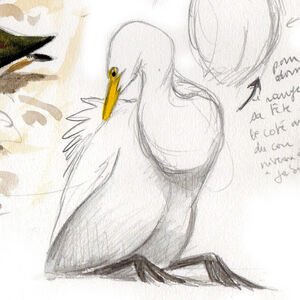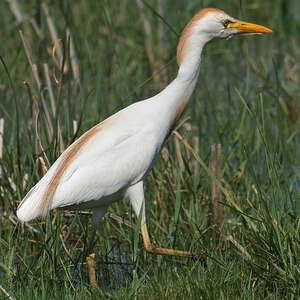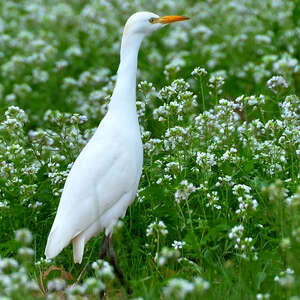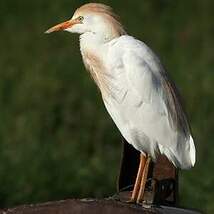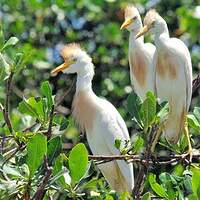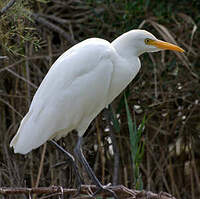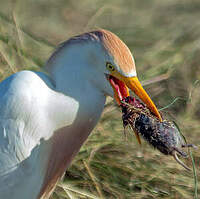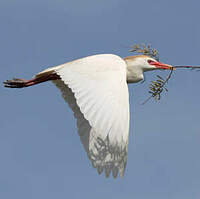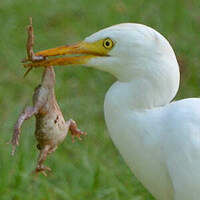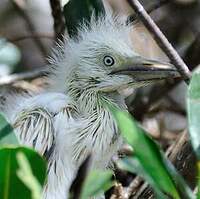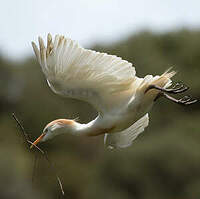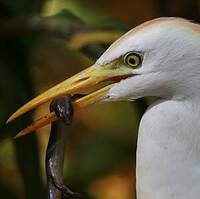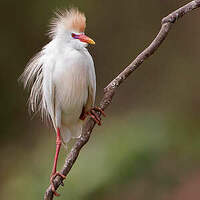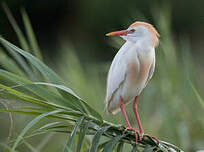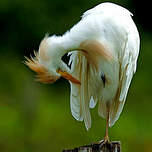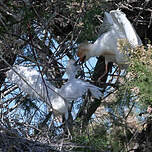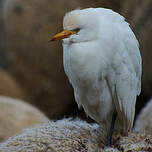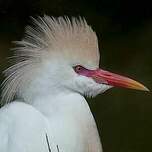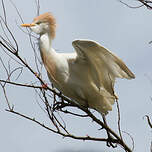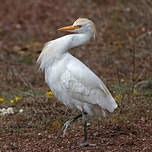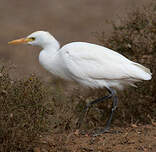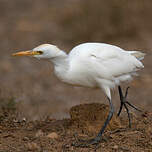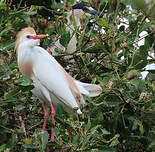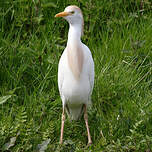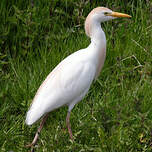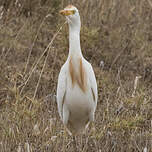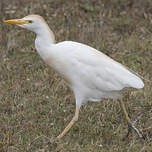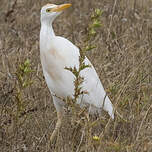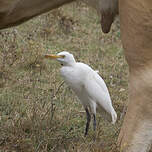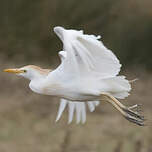Western Cattle Egret
Bubulcus ibis - Héron garde-boeufs
Identification
Present on every continent, very common in Africa, the Western Cattle Egret is a medium-sized wading bird. He often accompanies livestock in fields, which explains his name. It differs from other herons in its particular silhouette, at rest with the head and neck tucked into the shoulders.
This heron is slightly smaller than the Little Egret. It is known in two relatively different plumages. In nuptial plumage, it bears orange elongated feathers on the head, neck, chest and lower back. Its beak is bright orange and its legs are pink. The iris is yellow. In interstitial and juvenile plumage, it is entirely white with dark legs. Its beak is orange.
Subspecific information monotypic species
Foreign names
- Héron garde-boeufs,
- Garcilla bueyera,
- carraceiro-ocidental,
- Kuhreiher,
- pásztorgém,
- Koereiger,
- Airone guardabuoi,
- kohäger,
- Kuhegre,
- hltavka chochlatá,
- volavka rusohlavá,
- Kohejre,
- lehmähaikara,
- Veereier (Bosluisvoël),
- esplugabous,
- Kúhegri,
- czapla złotawa,
- lopu gārnis,
- kravja čaplja,
- Египетская цапля,
- Kuntul kerbau,
- ニシアマサギ,
- 西牛背鹭,
- 西方牛背鷺〔西方黃頭鷺〕,
Voice song and cries
Habitat
Unlike other herons, the Western Cattle Egret is not mainly associated with the aquatic environment. Although water and wetland areas continue to play an important role in its lifestyle, it is most often found in grassy steppes, meadows, crops, and even in artificial environments such as sports fields or urban lawns.
Behaviour character trait
This bird displays a highly developed gregarious instinct. It is almost always observed in groups. It nests in often densely populated wooded areas.
The search for food is often a collective quest as well: they can be seen in small groups taking advantage of the disturbance caused by cattle to capture their terrestrial prey. Western Cattle Egrets fly in groups, but unlike geese, cranes, and other cormorants, which are known for the more or less regular alignment of individuals, they form non-ordered groups.Flight
Dietfeeding habits
As a terrestrial predator, the Western Cattle Egret has a mainly insectivorous diet. It is often found in the company of livestock on which it perches. It takes advantage of the disturbance caused by cattle or agricultural machinery to capture insects and other arthropods, various other invertebrates as well as small vertebrates such as mice and shrews. It occasionally hunts with its feet in the water and fish can then enter its diet.
Reproduction nesting
Nesting is a business for both parents, but there is a fairly rigorous division of tasks: The female is in charge of construction itself, while the male is responsible for collecting the materials.
Built of twigs, the nest is installed in a bush or shrub on the edge of the water.When one of the partners returns to the nest, the couple adopts a ceremonial attitude with the back feathers erect and the head feathers flattened.
The female lays 4 to 5 bluish-green eggs that are alternately incubated by the male and female for 22 to 26 days. The young are nidicolous and fly away in about 30 days, but they are able to climb in the neighboring branches of the nest at the age of 2 to 3 weeks.
Geographic range
Threats - protection
Sources of information
- IOC World Bird List (v14.1), Gill, F and D Donsker (Eds). 2024-04-18.
Other sources of interest
 Specification sheet created on
28/10/2023 by Maelle Bujaud with help of Daniel Le-Dantec
Specification sheet created on
28/10/2023 by Maelle Bujaud with help of Daniel Le-Dantec partially rewritten on 00/00/0000 by Jean François
Translation by AI Oiseaux.net
published: 01-07-2003 - Updated: 24-11-2022
© 1996-2024 Oiseaux.net
- Accipitriformes
- Aegotheliformes
- Anseriformes
- Apodiformes
- Apterygiformes
- Bucerotiformes
- Caprimulgiformes
- Cariamiformes
- Casuariiformes
- Charadriiformes
- Ciconiiformes
- Coliiformes
- Columbiformes
- Coraciiformes
- Cuculiformes
- Eurypygiformes
- Falconiformes
- Galliformes
- Gaviiformes
- Gruiformes
- Leptosomiformes
- Mesitornithiformes
- Musophagiformes
- Nyctibiiformes
- Opisthocomiformes
- Otidiformes
- Passeriformes
- Pelecaniformes
- Phaethontiformes
- Phoenicopteriformes
- Piciformes
- Podargiformes
- Podicipediformes
- Procellariiformes
- Psittaciformes
- Pterocliformes
- Rheiformes
- Sphenisciformes
- Steatornithiformes
- Strigiformes
- Struthioniformes
- Suliformes
- Tinamiformes
- Trogoniformes

